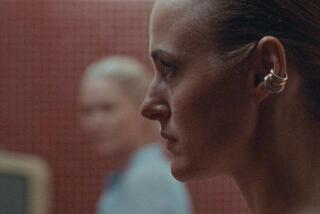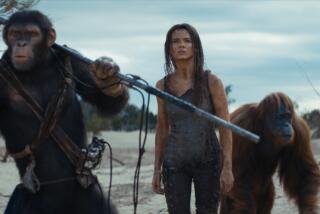MOVIE REVIEW : ‘Map of the Human Heart’: : An Epic Laced With Intimacy
- Share via
When a filmmaker dares greatly, tries to touch the sky, he or she runs the risk of looking absurd. Audiences quick to scoff at “pretension” may miss the grandeur lying right in front of them. Vincent Ward’s “Map of the Human Heart” (AMC Century 14), a startling epic of cultural seduction, has that kind of grand overreaching. It tries simultaneously to catch a massive chunk of our century in micro- and macrocosm, to chart the deep or evanescent emotions of its people and to soar up and scan the landscape in which they’re trapped. Often, it succeeds.
Spinning its tale of mixed races, of life among the Inuit or Eskimos, and the clash between civilization and primitivism, “Map” strikes familiar or classical chords in ways that are often dissonant, nerve-jangling. The movie has a weird, icy clarity, a hard-edged reverie. It suggests a dream, in which the imminent waking carries more anxiety than the dream itself.
The surface technique is sharp, brilliant; the framework--a tale of “star-crossed lovers”--almost as old as the movies themselves. In “Map,” two “metis” or mixed-race Inuit, meet as children in a Montreal Catholic hospital school, meet again in London during the last stages of World War II--where Avik (Jason Scott Lee) has become an aerial photographer and the memorably sensuous Albertine (Anne Parillaud) is now a photo analyst--and, in between and after, suffer a lifetime of frustrated longing.
*
In some ways, it’s a David Lean sort of story--thwarted romance against spectacular backdrops--but Ward’s focus, as in “Vigil” and “The Navigator,” is on the figure of a visionary child: the Inuit boy Avik, played with unforgettable buoyancy by 13-year-old Eskimo Robert Joamie. Yet the tale itself--which Avik relates, as a 40-ish alcoholic to a bemused younger mapmaker (John Cusack) in the ‘60s--is the melancholy remembrance of a prematurely old man, scoffing at his own romantic and youthful illusions.
That story has improbable symmetry, keyed by the dashing figure of British cartographer Walter Russell (Patrick Bergin), who plucked Avik from his village, and changed his life. It’s Walter who inspires Avik to flee his village--leaving behind, in a wrenching scene, his elderly, doomed grandmother (Jayko Pitseolak)--and who later dominates Avik’s “civilized” life. Yet Walter isn’t an ordinary villain, any more than Parillaud’s Albertine is a trifler. He’s an imperialist without illusions, and what seems to most obsess Ward is the irony in the collision of “civilization” and the “primitive”: the good brought, the havoc eventually wrought.
The movie keeps shifting perspectives between vast overhead views and eye-level shots that shrink the world to a face, a smile, a look. When Avik greets a descending helicopter near his snowbound village of Nunataaq, with his favorite expression, “Holy Boy! The Calvary’s here!” the religious double-entendre is intentional. This is a film, above all, about the danger of playing God.
The actors--Lee, Parillaud, Bergin, Cusack, Pitseolak, Jeanne Moureau as a fanatic nun, the children Joamie and Annie Galipeau--seem perfect. The photography, by Eduardo Serra, scintillates. Ward, who has made both documentaries (“In Spring, One Plants Alone,” on the Maori) and science-fantasy, (“The Navigator”), has a style that eerily mixes real and fantastic, truth and idealization. No scene in “Map” is more nightmarish than the Dresden firebomb raid. It’s a nightmare of reality.
Ward’s “Map” is a wildly ambitious film and, often, a wildly beautiful one--and if it isn’t quite a masterpiece, if we sense that Ward’s resources aren’t enough for the World War II London scenes, in the end, any flaws or lapses simply may not matter. Movies, especially ones with a broad epic canvas and international logistics, don’t often get this intimate. They don’t give you such a sense of nerves stripped raw, joy or misery nakedly expressed.
Nor do they try much for poetry--and in “Map of the Human Heart” (MPAA rated R, for language and sexuality), Ward is reaching for it, bravely and passionately, in every frame of the picture. Perhaps he’s a doomed cartographer, with the world exploding in flames beneath him--but at least he’s mapping his heart.
‘Map of the Human Heart’
Jason Scott Lee: Avik
Patrick Bergin: Walter Russell
Anne Parillaud: Albertine Hubert
Jeanne Moureau: Sister Banville
A Miramax Films presentation of a Working Title production. Director Vincent Ward. Producers Tim Bevan, Ward. Executive producer Graham Bradstreet. Screenplay by Ward, Louis Nowra. Cinematographer Eduardo Serra. Editor John Scott. Costumes Renee April. Production design John Beard. Art directors Jean-Baptiste Tard, John Frankish. Set decorators Michelle Forst, Diane Gauthier. Sound Raoul Freuhauf. Running time: 1 hour, 47 minutes.
MPAA-rated R (Some language, a scene of sexuality).
More to Read
Only good movies
Get the Indie Focus newsletter, Mark Olsen's weekly guide to the world of cinema.
You may occasionally receive promotional content from the Los Angeles Times.










